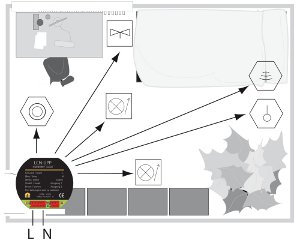on
off
Home automation
Home automation is the science about the application of electronics and IT (Information Technology) in the organization of home life.
It was born during the Third Industrial Revolution with the purpose of studying, finding instruments and strategies, in order to:
- improve the quality of life;
- improve safety;
- simplify the installation and the maintenance of the technology;
- reduce the management costs;
- transform the old rooms and the old systems.
Home automation plays an important role in making systems intelligent. The home space, which is defined as “intelligent home”, is adequatedly designed/planned and technologically equipped and makes systems capable of carry out partially autonomous functions (according to reactions to fixed space parameters) or functions programmed by the user or completely autonomous (according to the reactions to certain space parameters conducted by dynamic programs), available to the user.
So, home becomes intelligent not because there are some intelligent systems, but because the intelligent system that it possesses is capable of easily control and organize the operation of the systems which are present.
At a higher level, you talk about building automation. The intelligent building, supported by new technologies, permits the coordinated, integrated and computerize organization of the technological systems (air-conditioning, water, gas and power distribution, safety systems), the computer and the communication networks, with the purpose of improving the flexibility of organization, the comfort, safety and the quality of living and working inside the buildings.
So, you can talk about:
- Reliability: the system always works, without requiring particular attentions; even in case of damages, it must be capable of supply the service for which it has been projected or a similar service in case of reduced functioning; moreover it must be capable of signal the non-operation and create a report of the possible problems.
- Energy saving: a completely computerized system must avoid the costs produced by energy waste, due to forgetfulnesses or other situations.
- Computerization of daily actions: an home automation system must simplify some daily actions, especially the recurring ones, so it mustn't complicate them in any way.
The concept of intelligent home
The intelligent home can be controlled by the user through some appropriate user interfaces (like buttons, remote control, touch screen, keyboards and voice recognition), that bring into contact (that is, sending commands and receiving information) with the intelligent control system, based on a central computerized unit or on a distributed intelligence system. The different parts of the system are linked to each other and to the control system through different types of interconnection (for example local net, power line communication, radio waves, dedicated bus...).
The central control system, or all the peripherals in a distributed intelligence system, arrange for doing the user commands (for example lighting the kitchen light, or opening the living room rolling shutter), constantly monitoring the space parameters (like flood or the presence of gas), managing independently some adjustements (for example the temperature) and producing possible signals to the user or to the remote-support services. Automation systems are usually preset so as, whenever a command is activated/operated/actuated, the user is informed through a visual warning/confirmation signal of the performing of the task (for example, the coloured LED in the switches, the changes of the touch screen design), or with other types of signals (for example sound) in the systems for handicappeds.
Examples
Examples of functions of an intelligent electrical system:
- Independent coordination of the functioning of electrical appliances;
- Reduction of the magnetic field in the rooms in which there are users;
- Isolation and automatic protection in case of storm;
- Commanded or automatic disconnection of the technical parts (for example, Tv, decoder, video recorder...) at night or when there is nobody in the home.
Examples of functions of an intelligent air-conditioning system:
- Automatic functioning on the basis of the identification of the presence of people;
- Adaptation of the functioning on the basis of the humidity level;
- Automatic switch off of the radiator under an open window;
- Autoprogramming of the pre-conditioning (for example, preheating in winter) on the basis of the identification of the customs and traditions of the users.
Examples of functions of an intelligent safety system:
- Detection of some situations like gas leaks, floods and fires;
- Remote Connection with the assistance services (first aid and surveillance);
- Remote monitoring with video cameras of the rooms;
- Interaction between TV, telephone, videophone and video cameras system.
Examples of functions of an intelligent home automation system:
- Independent closing or opening of the awnings (if it is sunny they open, if it is windy they close);
- Independent closing or opening of the rolling shutters and coordination with automation for the ventilation on the basis of aero-lighting parameters dictated by law and coordination with the lighting scenarios (I switch on the videoprojector, so the automation darkens the room and then the lighting system switches on the soft lights).


